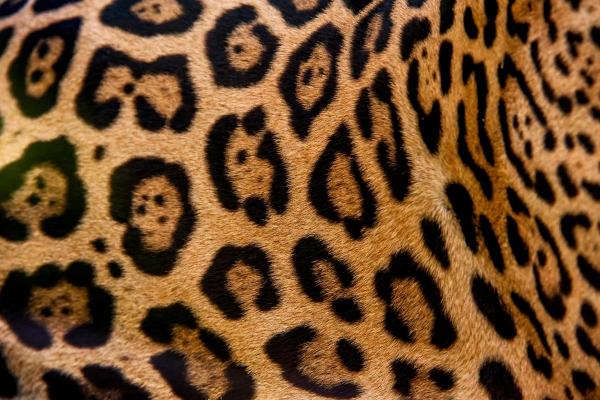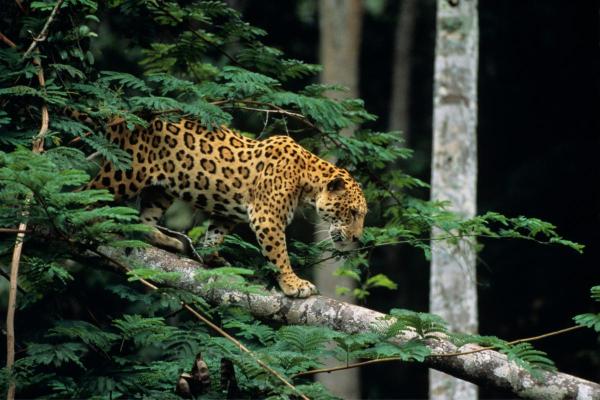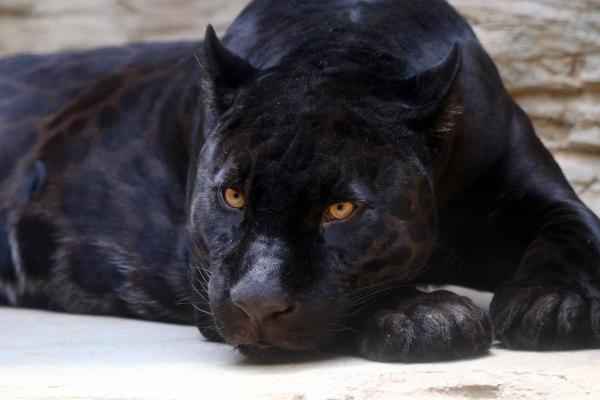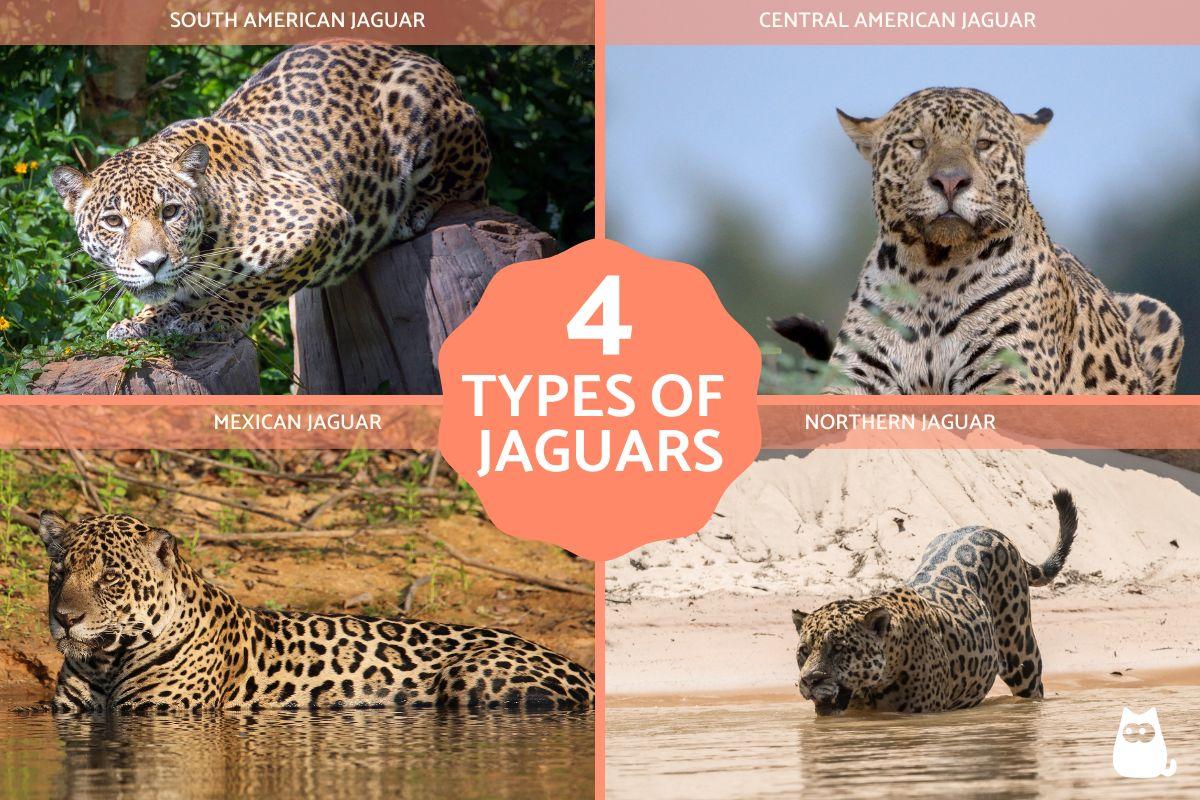Different Types of Jaguars


The jaguar (Panthera onca), the largest wild cat in the Americas and the third largest in the world, is a key apex predator. It plays a vital role in maintaining the balance of ecosystems across its range, which spans from the southwestern United States to northern Argentina. Modern genetic research identifies four distinct jaguar subspecies, each adapted to its specific geographic region and environment. It's not surprising, then, that these subspecies show significant variations in size, coat color, hunting strategies, and habitat preferences.
In this article, we'll examine the four recognized jaguar subspecies, their defining characteristics, geographic distributions, and the challenges they face in their increasingly fragmented habitats.
South American Jaguar (Panthera onca onca)
The South American Jaguar (Panthera onca onca) lives in the tropical forests of the Amazon basin and surrounding regions. Their distribution spans multiple countries including: Brazil, Peru, Colombia, Ecuador, Venezuela, Guyana, Suriname, and French Guiana.
They also inhabit the Pantanal, a vast wetland region shared between Brazil, Bolivia, and Paraguay. In fact, the jaguars that inhabit this area have developed a specialized hunting technique where they can detect fish movement by watching water ripples and catch them with a quick paw swipe.
These big cats are the largest felines in the Americas. Males typically weigh between 56-96 kg (123-212 lbs), while females are smaller, ranging from 43-77 kg (95-170 lbs). Their coat features well-defined rosettes (spots) that are larger than those of other big cats, with small dots or markings inside them. This is a detail that sets them apart from leopards.
South American Jaguars adapt well to different hunting conditions. They excel in water and on land, showing excellent swimming abilities that let them hunt aquatic prey such as caimans, turtles, and fish. They are the only big cats that regularly hunt adult black caimans, sometimes taking on prey larger than themselves by using a specific skull-piercing bite technique.
Not only that, but they also hunt land animals including tapirs, peccaries, deer, monkeys, and capybaras. Furthermore, they can also climb trees skillfully, pursuing prey into the canopy when needed. The dense, humid rainforest environment gives them good camouflage for hunting.
It is important to note that they have the strongest bite force relative to body size of any big cat, with a bite force quotient (BFQ) of 137, allowing them to pierce turtle shells and crack open coconuts.
Unfortunately, these cats face several threats to their survival:
- Ongoing deforestation of their habitat
- Broken habitat that separates populations
- Poaching
- Decreasing prey populations
These pressures have caused population declines across much of their range. They are currently classified as Near Threatened by the IUCN. Did you know jaguars once ranged from Argentina to the United States? Discover their complete historical and current distribution in our companion guide.
Central American Jaguar (Panthera onca centralis)
The Central American Jaguar inhabits the forests and jungles stretching from southern Mexico through Central America. Their distribution includes:Belize, Guatemala, Honduras, Nicaragua, Costa Rica, and Panama. Additionally, small populations can be found in parts of El Salvador.
These cats are mid-sized among jaguar subspecies. Males weigh between 60-90 kg (132-198 lbs), while females range from 40-70 kg (88-154 lbs).
Their coat coloration shows high variability, from light golden to reddish-brown and deep ochre, adapting to their diverse habitats. Their rosettes tend to be more compact compared to their South American cousins.
Central American Jaguars thrive in various environments, from dense tropical forests to pine woodlands and coastal regions. They maintain territories in mountainous regions up to 2,000 meters above sea level, adapting to cool cloud forests, a behavior not commonly seen in other jaguar populations.
They hunt diverse prey including peccaries, deer, monkeys, coatis, and agoutis. In coastal areas, they also feed on marine turtles and their eggs during nesting season. In fact, they have developed specialized hunting techniques for sea turtles, waiting on beaches during nesting season and flipping them over before they reach the water.
They show a particular preference for hunting nine-banded armadillos, using their powerful paws to dig them out of burrows, a hunting strategy specific to this subspecies.
These cats also face significant challenges, including forest fragmentation, the expansion of agricultural lands, road construction, the growth of human settlements, and a reduction in the availability of their prey. Their IUCN Status is Near Threatened.
Want to know what makes jaguars such successful predators? Explore their hunting behaviors and dietary habits in our companion guide.

Mexican Jaguar (Panthera onca goldmani)
The Mexican Jaguar primarily inhabits the regions of the Yucatan Peninsula, Chiapas, and Oaxaca, extending through parts of southern Mexico. Their range includes both tropical forests and semi-arid landscapes. They have adapted to survive in desert environments, something rare among jaguars, and can go longer without water than other subspecies by getting moisture from their prey.
These jaguars are smaller compared to their southern relatives. Males typically weigh between 50-80 kg (110-176 lbs), while females range from 35-60 kg (77-132 lbs). Their coat tends to be lighter in color, often displaying a pale golden hue that provides effective camouflage in the more open, drier habitats they occupy.
Mexican Jaguars, like other big cats, are generally solitary animals, establishing and defending territories. Their diet centers on local prey, such as white-tailed deer, collared peccaries, nine-banded armadillos, coatis, and wild turkeys. They are the only jaguar population known to regularly hunt and eat wild turkeys, developing specific hunting strategies for these quick birds.
These jaguars hold deep cultural significance in Mexican heritage, particularly among indigenous communities where they are often viewed as sacred animals and feature prominently in traditional art, mythology, and spiritual practices. Archaeological evidence shows they were depicted in Olmec art over 3,000 years ago, making them one of the longest-documented jaguar populations in cultural history.
Current threats include urban development, agricultural expansion, direct persecution by ranchers, mining operations, and tourism development. Due to these threats, Mexican Jaguar populations have declined dramatically, leading to their classification as Endangered. It's estimated that fewer than 4,000 individuals remain in the wild.
Curious about what sets jaguars apart from their spotted cousins? Our comparison article reveals the distinct features of each big cat species.

Northern Jaguar (Panthera onca arizonensis)
The Northern Jaguar historically ranged throughout the southwestern United States (Arizona, New Mexico, Texas) and northern Mexico (Sonora, Chihuahua). Today, their primary range has contracted to a small area in northern Mexico, with only occasional sightings in the southern United States.
They're the only jaguar population that has adapted to survive in true desert conditions, able to withstand temperatures ranging from below 0°C (32°F) to over 49°C (120°F). They can travel up to 112 kilometers (70 miles) in a single night searching for water during dry seasons, the longest recorded distance for any jaguar subspecies.
These jaguars are the smallest of all subspecies. Males weigh between 50-70 kg (110-154 lbs), while females typically range from 30-50 kg (66-110 lbs). Their coat displays a paler coloration with less pronounced rosettes compared to other subspecies, an adaptation that provides better camouflage in their arid habitat.
Their prey includes white-tailed deer, mule deer, collared peccaries, desert cottontail rabbits, jackrabbits, and various small mammals. They've adapted their hunting techniques to the sparse vegetation and open spaces of their desert habitat.
Current threats affecting their survival include border wall construction, ranch development, water scarcity, human-wildlife conflict, and limited genetic diversity. Due to these threats, Northern Jaguar populations have been decimated. Current estimates suggest fewer than 100 individuals remain in the wild, making this subspecies Critically Endangered.
Black Jaguar (Panthera onca)
While jaguars typically display the familiar golden coat with black rosettes, several natural color variations occur across all subspecies. The most striking of these is melanism.
A melanistic jaguar, often called a black panther in the Americas, results from a genetic mutation affecting melanin production. Their seeming solid black coat comes from an excess of dark pigmentation. This coloration is caused by a dominant allele, meaning a cub needs to inherit the gene from only one parent to display the trait.
Under sunlight or strong lighting, the traditional rosette pattern remains visible beneath the black coloration, appearing as darker black spots against the deep black base coat. This phenomenon, known as "ghost striping," helps researchers identify individual black jaguars through their unique spot patterns.
The melanistic variant appears across all jaguar territories but occurs most frequently in dense rainforest regions.
Beyond melanism, jaguars show various color adaptations based on their habitat:
- Rainforest populations: often display darker, more saturated golden coats. Black coloration aids hunting in dense, dark forest understory. Also, standard spotted patterns break up the body outline in dappled forest light.
- Open wetland populations: tend toward lighter, paler coloration. Lighter coats provide better camouflage in open, sunlit areas.
- Arid region populations: show more cream or pale golden coats.
All color variants face the same threats as typical jaguars. However, in some areas, black jaguars face additional hunting pressure due to their perceived rarity or cultural significance. Did you know that 'black panther' refers to multiple species? Dive deeper into the fascinating world of melanistic big cats in our comprehensive guide.

If you want to read similar articles to Different Types of Jaguars, we recommend you visit our Facts about the animal kingdom category.
- Ruiz-García, M., & Payan, E. (2013). Craniometric Variation in Jaguar Subspecies (Panthera onca) from Colombia . Molecular Population Genetics, Phylogenetics, Evolutionary Biology and Conservation of the Neotropical Carnivores, 465-484.
- Ruíz-García, M., & Payán-Esteban, C. (2001). Genetic structure and demographic history of the Jaguar (Panthera onca) in Colombia: Contrast between molecular markers and craniometric data .
- Ruiz-Garcia, M., Payán, E., Murillo, A., & Alvarez, D. (2006). DNA microsatellite characterization of the jaguar (Panthera onca) in Colombia . Genes & genetic systems, 81(2), 115-127.








